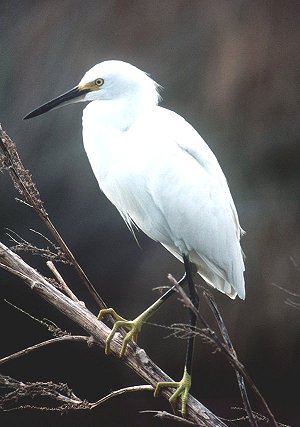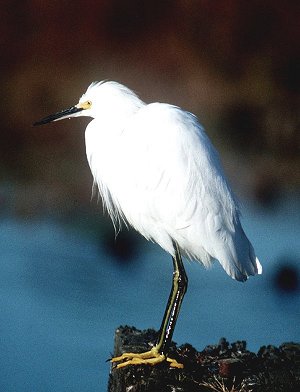|
Snowy Egret Egretta thula Garza Blanca,
|
 |
|
Photo: G. Beaton
|
|
IDENTIFICATION: An all-white heron with black legs and bill, and yellow feet. Breeding birds have long, showy white neck feathers called aigrettes. The skin at the base of the bill is yellow (orange in breeding season). Immature birds have variable amounts of yellow-green color on the legs. Length: 56-66 cm.; weight: 370 g. VOICE: A low-pitched squawk, but not particularly vocal away from breeding sites. Audio (M. Oberle). HABITAT: Lagoons, rivers, marshes, mangroves and ponds. HABITS: Feeds on small fish, amphibians, snakes, crabs, insects, and other invertebrates. It uses its yellow feet to stir up mud and startle its prey, which it grabs with a quick dart of its long bill. Like other egrets, it often flashes its wings open to startle or herd its prey. The Snowy Egret nests in colonies, often with other heron species, in swamps and on mangrove islands. The nest is made of sticks and contains 3-5 blue-green eggs. After the breeding season, the Snowy Egret wanders more widely inland away from the coast. In winter the resident Snowy Egret population is augmented by northern migrants. One Snowy Egret banded in Connecticut was recovered in Puerto Rico. STATUS AND CONSERVATION: Common, permanent resident of Puerto Rico in appropriate habitat. In the late Nineteenth Century, the elaborate feathers in the breeding plumage were used in women's hats. The Snowy Egret was in danger of extinction due to hunting pressure. As late as 1910, plumes were reported for sale in Caguas. But the Snowy Egret population has recovered dramatically under legal protection. RANGE: Southern North America, through the Caribbean and Central America, to northern Chile and Argentina. Typical sites to find this species are the ponds at the Boquerón Wildlife Refuge and the salt flats at Cabo Rojo in southwestern Puerto Rico. TAXONOMY: CICONIIFORMES; ARDEIDAE |
|
 |
|
Photo: A. Sánchez Muñoz
|
 |
|
Photo: A. Sánchez Muñoz
|
 |
|
|
Immature bird - Photo: G. Beaton |
